WWDC - what does Apple bet on in 2017?
Bealex and I are back at WWDC, Apple’s main developer conference. This year they presented both updates in the system frameworks and APIs, as well as new devices. After all, today's announcements will have a strong impact on how we will use mobile devices on iOS and Android in the near future, so we are in a hurry to share the observations of the first day.

iOS 11, new iPad Pro and Macs, HomePod column and much more - under the cut.
')
Apple, the company that Steve Jobs called software, focuses on just four platforms: iOS, macOS, watchOS and tvOS. Devices that are material containers for these operating systems, fade into the background: we use applications and the network, and from the hardware we, in fact, need a window into this world. By making our choice in favor of Apple, Google or Microsoft, we become hostages of the ecosystem, and every year we are drawn deeper and deeper inside.
In recent years, Apple is lagging behind the fact that Apple is lagging behind everyone in machine learning and smart algorithms. At the Google I / O conference, the words machine learning, deep neural networks, and artificial intelligence were pronounced as often as Apple uses the amazing, revolutionary and best device we ever made epithets on Apple presentations. The world is changing, and the more actions happen automatically, the more we are happy.
This year, at WWDC we have made a big bet on using the phone as an augmented reality browser. Less than a year, as everyone is obsessed with Pokemon Go, and AR becomes available to all developers through a set of simple APIs. IPhone automatically uses data from the camera, accelerometer and compass in order to find planes (tables, floor) in space, determine their size and track device movements. Able even to select the lighting conditions so that the inserted objects merge with the environment.
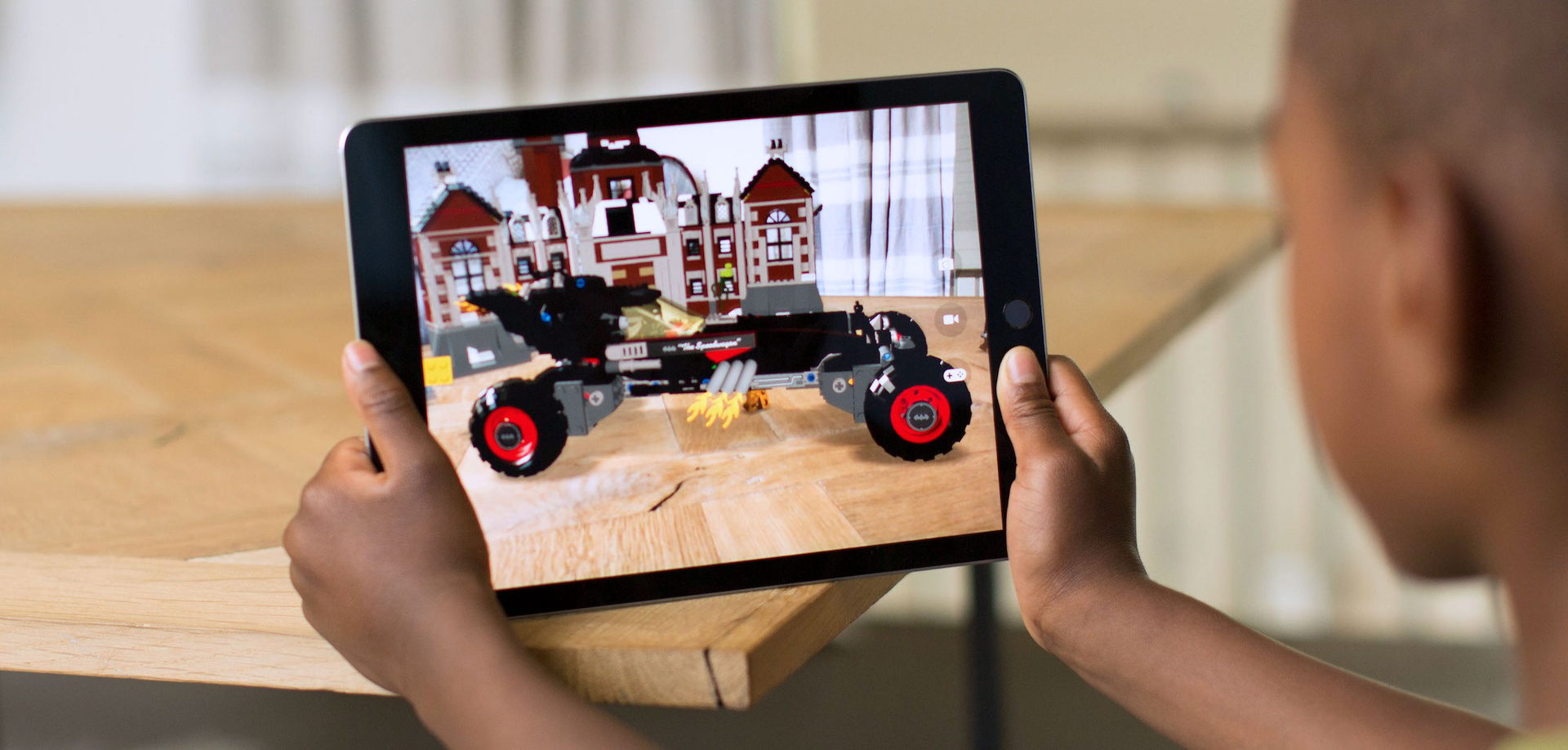
A set of low-level APIs for machine learning can be used to work with camera images. Out of the box, the iPhone can detect faces and follow arbitrary objects in the frame, but you can load your own trained models. You can define documents on the image and scan them.
IOS has a built-in natural language text engine. Categorization, data extraction from the context become available for all applications. Whether it will be possible to work with the Russian language, or at least load their own models - is not yet clear.
Siri now works in the same context on all devices, syncing via iCloud. It is more and more like Google Assistant. With the help of neural networks, she says the words each time a little differently, so that her speech is more human.
A small but important innovation: through Apple Pay you can now transfer money to friends and acquaintances. You can accurately send and request them via iMessage, but whether it will be possible to integrate it with other applications is a question. This is the final touch, now the Apple ecosystem provides a full range of banking services: cards, payments in stores and online, P2P transfers. While all banks are playing the “we are an IT company” game, Apple, a real IT company, rather quickly transferred a large share of transactions to themselves right under their noses.
iOS will recognize when you go in the car, and automatically block SMS, notifications, chats and everything else that distracts from the road.
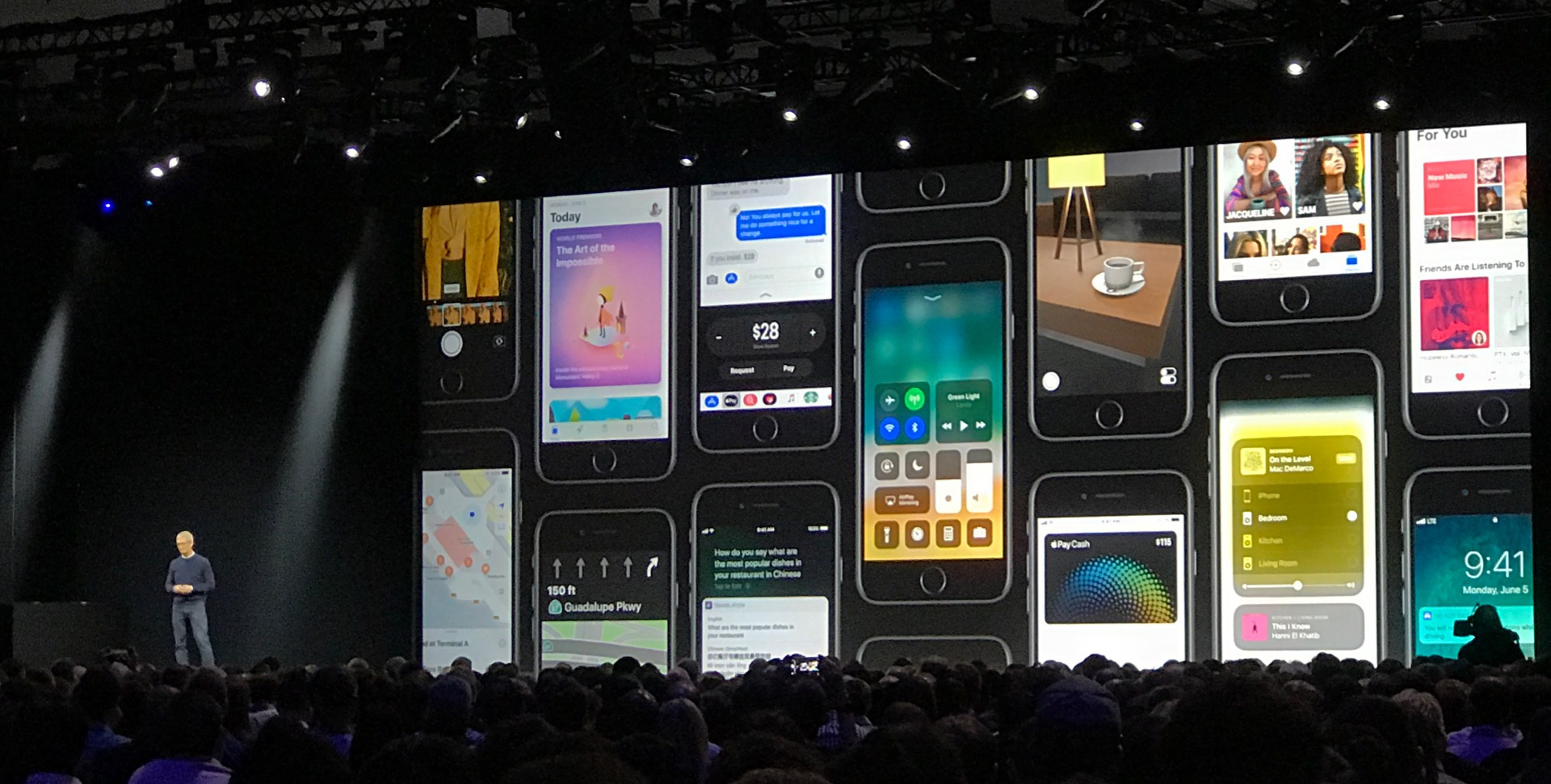
The demand for the iPad has fallen when smartphones have grown to large screens. Before the full-fledged working tool, this device did not reach even with an external keyboard, and this year Apple again tries to return some sort of isolated status to the tablet.
The multitasking mode is complemented by dragging and dropping files of any type between different applications, and desktop management more and more resembles full-fledged macOS. The screen size was increased to 10.5 inches due to thinner frames, and the refresh rate of 120 Hz and enhanced color rendition work to improve the picture quality.
The Files app, which lit up in appstore a few hours before WWDC, is what turns the tablet into a working tool. In fact, a full-fledged file manager has now appeared on iOS.

For Apple, it’s not typical to present many devices at WWDC, but this year, in addition to iPads and a new column, almost all Macs were updated.
Macbooks and iMac are faster, and this is being done with an emphasis on preparing VR content. A new generation of professional desktops will come to replace the Mac Pro bucket - iMac Pro in black, with a black keyboard and mouse or trackpad. In the top-end configuration promise to put the 18-core Xeon, Radeon Vega and up to 128 GB of ECC-memory. Will begin selling at the end of the year.
The new version of macOS was called High Sierra, it has a strong bet on increasing productivity and speed of work. Also, Apple once again decided to abandon the outdated legacy - a new APFS file system appeared, support for the H.265 codec with native acceleration, instead of JPEG, the HEIF codec is being promoted.
The low-level fast computing framework Metal has been updated to version 2.0, now it is proposed to be used for machine learning and other time-consuming computing, and not just for games.
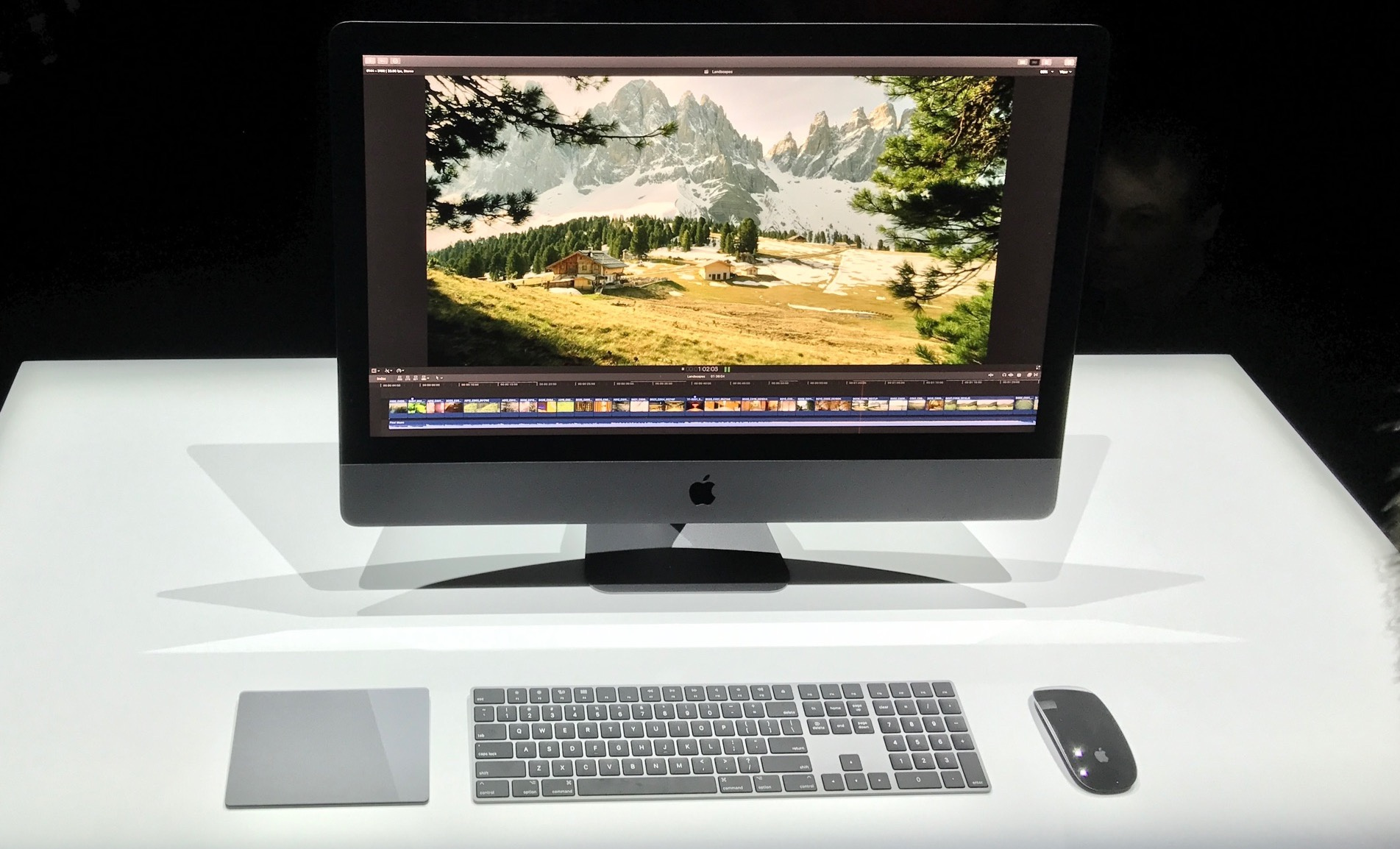
Tim Cook says the team has been working on a revolutionary and unique speaker for several years, and in the end the sound will be overwhelming. So far, neither visitors nor journalists have been able to verify this, and they promise to sell the column in December. Built-in Siri functionality repeats the way Google Home and Amazon Echo work. The main focus here is on sound quality; for this, the speaker adapts to the geometry of the room, and for the stereo mode you can put two of them.
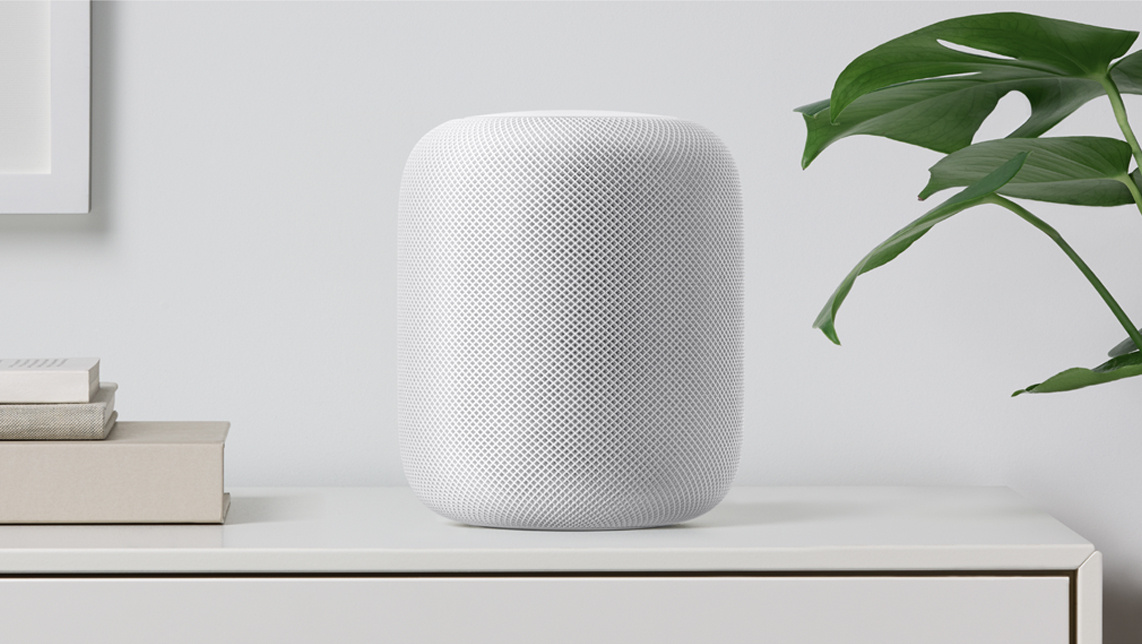
The most important part for developers, of course, is Xcode. Every year his update seemed forced, sort of like "they updated the API / language / ..., and Xcode is needed, well, at least somehow." The basis remained the same, the editor was still the same. Sometimes various little things were updated from all sides (review of documentation, or Interface Builder), but in general, the main tool was trampled down.
Now Xcode is updated really well. Completely copied to Swift editor, which did not touch a wild number of years. For example, you can finally increase leading (if you think that this is nonsense, try it yourself, that's better). Error descriptions have changed, and now they do not break the layout of the code. Cross-language refactorings and “code transformations” have appeared, and Apple promises to give all developers the opportunity to create their own.
Some refactorings work exactly as needed, for example, renaming. Beautiful, fast. A piece is nothing more than a new way to insert templates. Some have long been known for JetBrains products (extracts).
Xcode is slowly becoming like a modern editor, and not something that "is necessary, because you need at least something."
Now you can develop and debug applications over the network using WiFi to connect. The convenience of such work will still need to be checked (there is a doubt that this will work sufficiently quickly), but for the opportunity - many thanks.
You can run several simulators at once, which is very necessary in UI testing and the interaction of applications with each other.
Improved and debugging tools. Two new analyzers appeared: the first one checks the correctness of the calls to the interface methods, the second one - all sorts of indefinite things like division by zero.
A lot of slides were devoted to acceleration in general: they tried to speed everything up. The editor was created from scratch, keeping in mind the need to quickly display huge files. The build system has been rewritten to better use multiprocessor systems and improve dependency tracking and code changes. Accelerated UI tests. And the search was generally sped up "50 times."
Yes, and now also folders on the disk and groups in Xcode are synchronized.
A little more than a year ago, when Phil Schiller took command of the App Store, changes began to pour into him. For example, review speed decreased by an order of magnitude. The store itself is updated, both visually and in essence .
Huge lists of disparate applications will no longer be. Supervised sections will get beautiful descriptions, and the design has become minimalist. If earlier a big pack of updates fell out once a week, now updates will be shorter, but every day.
App Store curators will have new tools. It will be possible to advertise not only the company or the application, but make a link directly to the in-app purchase or insert video into the tape.
And, of course, now developers are available to gradually roll out their application to the audience.
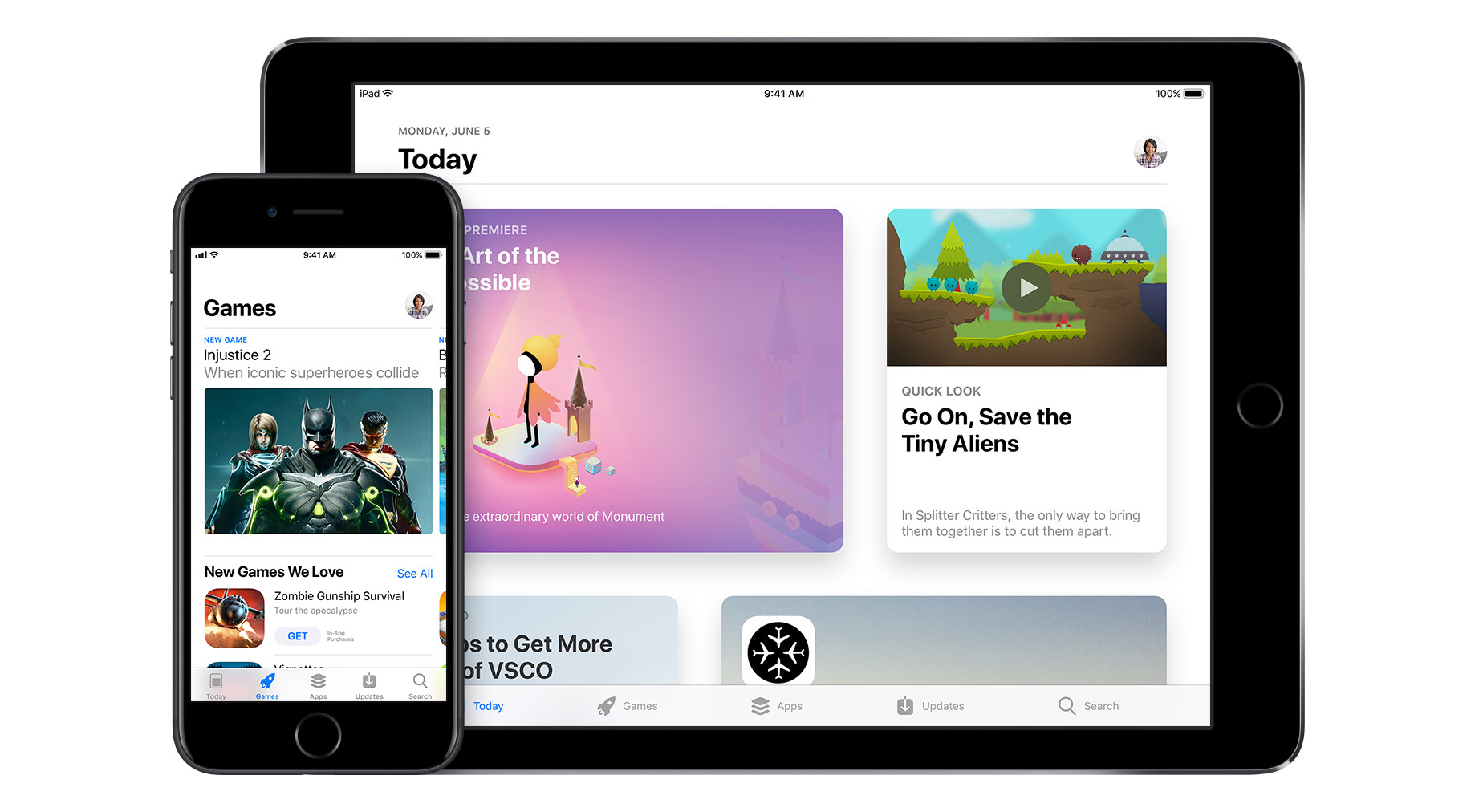
A huge number of new libraries requires careful consideration:
Sessions about all this have yet to be seen, considered and understood how it can be used to create new applications.

iOS 11, new iPad Pro and Macs, HomePod column and much more - under the cut.
')
Apple, the company that Steve Jobs called software, focuses on just four platforms: iOS, macOS, watchOS and tvOS. Devices that are material containers for these operating systems, fade into the background: we use applications and the network, and from the hardware we, in fact, need a window into this world. By making our choice in favor of Apple, Google or Microsoft, we become hostages of the ecosystem, and every year we are drawn deeper and deeper inside.
Machine Learning and iOS
In recent years, Apple is lagging behind the fact that Apple is lagging behind everyone in machine learning and smart algorithms. At the Google I / O conference, the words machine learning, deep neural networks, and artificial intelligence were pronounced as often as Apple uses the amazing, revolutionary and best device we ever made epithets on Apple presentations. The world is changing, and the more actions happen automatically, the more we are happy.
AR
This year, at WWDC we have made a big bet on using the phone as an augmented reality browser. Less than a year, as everyone is obsessed with Pokemon Go, and AR becomes available to all developers through a set of simple APIs. IPhone automatically uses data from the camera, accelerometer and compass in order to find planes (tables, floor) in space, determine their size and track device movements. Able even to select the lighting conditions so that the inserted objects merge with the environment.

ML, image processing
A set of low-level APIs for machine learning can be used to work with camera images. Out of the box, the iPhone can detect faces and follow arbitrary objects in the frame, but you can load your own trained models. You can define documents on the image and scan them.
NLP, Siri
IOS has a built-in natural language text engine. Categorization, data extraction from the context become available for all applications. Whether it will be possible to work with the Russian language, or at least load their own models - is not yet clear.
Siri now works in the same context on all devices, syncing via iCloud. It is more and more like Google Assistant. With the help of neural networks, she says the words each time a little differently, so that her speech is more human.
Apple pay
A small but important innovation: through Apple Pay you can now transfer money to friends and acquaintances. You can accurately send and request them via iMessage, but whether it will be possible to integrate it with other applications is a question. This is the final touch, now the Apple ecosystem provides a full range of banking services: cards, payments in stores and online, P2P transfers. While all banks are playing the “we are an IT company” game, Apple, a real IT company, rather quickly transferred a large share of transactions to themselves right under their noses.
DND while driving
iOS will recognize when you go in the car, and automatically block SMS, notifications, chats and everything else that distracts from the road.

New iPad Pro
The demand for the iPad has fallen when smartphones have grown to large screens. Before the full-fledged working tool, this device did not reach even with an external keyboard, and this year Apple again tries to return some sort of isolated status to the tablet.
The multitasking mode is complemented by dragging and dropping files of any type between different applications, and desktop management more and more resembles full-fledged macOS. The screen size was increased to 10.5 inches due to thinner frames, and the refresh rate of 120 Hz and enhanced color rendition work to improve the picture quality.
The Files app, which lit up in appstore a few hours before WWDC, is what turns the tablet into a working tool. In fact, a full-fledged file manager has now appeared on iOS.

Mac and High Sierra
For Apple, it’s not typical to present many devices at WWDC, but this year, in addition to iPads and a new column, almost all Macs were updated.
Macbooks and iMac are faster, and this is being done with an emphasis on preparing VR content. A new generation of professional desktops will come to replace the Mac Pro bucket - iMac Pro in black, with a black keyboard and mouse or trackpad. In the top-end configuration promise to put the 18-core Xeon, Radeon Vega and up to 128 GB of ECC-memory. Will begin selling at the end of the year.
The new version of macOS was called High Sierra, it has a strong bet on increasing productivity and speed of work. Also, Apple once again decided to abandon the outdated legacy - a new APFS file system appeared, support for the H.265 codec with native acceleration, instead of JPEG, the HEIF codec is being promoted.
The low-level fast computing framework Metal has been updated to version 2.0, now it is proposed to be used for machine learning and other time-consuming computing, and not just for games.

HomePod column
Tim Cook says the team has been working on a revolutionary and unique speaker for several years, and in the end the sound will be overwhelming. So far, neither visitors nor journalists have been able to verify this, and they promise to sell the column in December. Built-in Siri functionality repeats the way Google Home and Amazon Echo work. The main focus here is on sound quality; for this, the speaker adapts to the geometry of the room, and for the stereo mode you can put two of them.

Developer tools. Xcode
Editor
The most important part for developers, of course, is Xcode. Every year his update seemed forced, sort of like "they updated the API / language / ..., and Xcode is needed, well, at least somehow." The basis remained the same, the editor was still the same. Sometimes various little things were updated from all sides (review of documentation, or Interface Builder), but in general, the main tool was trampled down.
Now Xcode is updated really well. Completely copied to Swift editor, which did not touch a wild number of years. For example, you can finally increase leading (if you think that this is nonsense, try it yourself, that's better). Error descriptions have changed, and now they do not break the layout of the code. Cross-language refactorings and “code transformations” have appeared, and Apple promises to give all developers the opportunity to create their own.
Some refactorings work exactly as needed, for example, renaming. Beautiful, fast. A piece is nothing more than a new way to insert templates. Some have long been known for JetBrains products (extracts).
Xcode is slowly becoming like a modern editor, and not something that "is necessary, because you need at least something."
Development, testing, debugging
Now you can develop and debug applications over the network using WiFi to connect. The convenience of such work will still need to be checked (there is a doubt that this will work sufficiently quickly), but for the opportunity - many thanks.
You can run several simulators at once, which is very necessary in UI testing and the interaction of applications with each other.
Improved and debugging tools. Two new analyzers appeared: the first one checks the correctness of the calls to the interface methods, the second one - all sorts of indefinite things like division by zero.
A lot of slides were devoted to acceleration in general: they tried to speed everything up. The editor was created from scratch, keeping in mind the need to quickly display huge files. The build system has been rewritten to better use multiprocessor systems and improve dependency tracking and code changes. Accelerated UI tests. And the search was generally sped up "50 times."
Yes, and now also folders on the disk and groups in Xcode are synchronized.
App Store
A little more than a year ago, when Phil Schiller took command of the App Store, changes began to pour into him. For example, review speed decreased by an order of magnitude. The store itself is updated, both visually and in essence .
Huge lists of disparate applications will no longer be. Supervised sections will get beautiful descriptions, and the design has become minimalist. If earlier a big pack of updates fell out once a week, now updates will be shorter, but every day.
App Store curators will have new tools. It will be possible to advertise not only the company or the application, but make a link directly to the in-app purchase or insert video into the tape.
And, of course, now developers are available to gradually roll out their application to the audience.

Still ahead
A huge number of new libraries requires careful consideration:
- ARKit (augmented reality),
- Core ML (machine learning),
- MusicKit (access to music from third-party applications),
- AirPlay 2 (enhanced AirPlay)
- new domains in SiriKit (lists, notes, QR codes),
- Drag and Drop support for iPad
- scanning QR codes
- new opportunities for photo applications (getting a deep map of a photo),
- new video and photo codecs ...
Sessions about all this have yet to be seen, considered and understood how it can be used to create new applications.
Source: https://habr.com/ru/post/330298/
All Articles